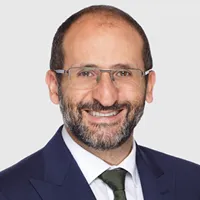Investing in Infrastructure: Why Now?
A conversation with Portfolio Manager Charles Hamieh
Infrastructure has recently seen increased attention as broad equities have been weaker due to inflation, rising interest rates, global supply chain disruptions from COVID-19 and the war in Ukraine. Charles Hamieh, Portfolio Manager, discusses the opportunities and potential income benefits for investors in the space today.
Investing in Infrastructure: Why Now?
With equities weaker and trading on fast-moving events such as the Fed’s aggressive rate hikes and war in Ukraine, infrastructure’s long-term proposition has been looking more attractive to investors. This is because infrastructure returns are driven by investment plans in essential services, which span ten or more years into the future, accelerate over time, and provide considerable predictability compared to more volatile equities.
The relative predictability of infrastructure returns is delivered by regulated and contracted assets, which are our focus as we build infrastructure portfolios. With regulated assets such as water, electricity and gas transmission and distribution, a regulator determines the revenues a company should earn on its assets. Because demand for these assets is steady and the regulator determines revenue, this mechanism leads to a relatively stable cash flow profile over time. Additionally, regulated assets are often monopolies and are typically defensive and generate high amounts of income.
We also focus on user-pay assets, which include airports, ports, rail, toll roads and communication infrastructure — these are long-term concession contracts leveraged to the growth in the underlying economy, which is to say to the volumes of people and cargo flying, moving through ports, along railways, or using cellular towers.
Infrastructure’s Inflation Hedge
Two key features of infrastructure should interest investors right now. First, its power as an inflation hedge. Inflation has been running hot globally as the COVID-19 crisis has waned and demand for goods and services returned. The war in Ukraine gave inflation a further jolt: Europe consumes about 45% of Russian gas, and as Europe and other parts of the world try to wean their way off Russian gas, effectively lowering supply and creating demand, that has resulted in an increase in commodity prices.
Commodity inflation has had little impact so far on regulated assets, but more broadly infrastructure is able to adjust to inflationary environments due to the largely pre-programmed way it builds inflation into regulation and contracts. This applies to both regulated utilities, which regularly reset their allowed returns with regulators to account for inflationary cost increases, and user-pays assets, such as toll roads or rail, as both types of infrastructure generate inflation-linked revenues.
Infrastructure’s pricing power comes from the essential nature of its assets: even at times of economic weakness, consumers continue to use water, electricity and gas; drive cars on toll roads, and use other essential infrastructure services. Just as importantly, the income we look for from infrastructure is underpinned by long-term contracts, which ensure a steady flow of revenue over a long period.
The Move Toward Net Zero
The second key feature driving interest in infrastructure is its central role in the global trend of decarbonization. In our view, decarbonization, or the move toward net-zero carbon emissions, provides strong investment tailwinds for infrastructure. Infrastructure and utilities are at the forefront of this effort and can offer investors a stable return on equity without taking technology risk. Annual power sector capital spending is expected to increase from US$760 billion in 2019 to US$2.5 trillion (in 2019 dollars) by 2030, with approximately half spent on solar, wind and other renewable energy generation and a third on modernizing and extending electricity networks.
In an environment where coal plants are being retired or are used far less, and gas is used as a transition fuel, more spending must occur for renewables to meet power demands. In our estimation, spending on wind and solar energy infrastructure needs to accelerate at least 10x more from current levels, and this will flow through to allowed returns for regulated utilities building out these resources.
Electric vehicles have also been gaining more consumer acceptance.: In some estimates, around 20% of vehicles sold annually today are electric, but by 2030, that is expected to increase to 60%, although figures differ from country to country. Particularly with high fuel prices top of mind, electric vehicle sales seem likely to continue accelerating.
Other consumer transportation changes might result from global decarbonization. Rising fuel prices and rising emissions also affect air travel. Airlines could be taxed if flights are too short, making rail and public transit look more appealing to some consumers.
And while energy infrastructure pipelines have seen renewed interest as energy security has become a strategic priority (in Europe, for example), midstream pipelines are also beginning to facilitate an energy transition through hydrogen or carbon capture and storage, developing technologies that will only have an increasing role in net-zero efforts.
So there are several areas of infrastructure benefiting from decarbonization tailwinds, not to mention other secular trends like 5G driving investment in communication towers, and with its ability to largely pass-through inflation as well as provide current income, infrastructure’s attractiveness now is no surprise.
There are several ways to invest in infrastructure; our preference is to focus on a diversified group of large, liquid, high-quality infrastructure companies around the world. We want companies with strong, predictable cash flows — what we don’t want are illiquid assets and companies with volatile cash flows, including competitive assets and businesses, which tend to be unregulated and carry commodity price risk. We also see private infrastructure capital continuing to come to listed markets to find attractively priced assets for acquisition. Currently, with over USD $300 to $400 billion of dry powder, or capital waiting to be invested, unlisted players will benefit the companies in our listed infrastructure universe as these companies sell these assets, often non-core or minority interests, for well in excess of where they are currently trading. On average, we have seen these sales done at roughly a 30% premium to where they are currently trading or their implicit value within these companies.
In summary, we believe the opportunity set for infrastructure investors is only set to grow, with a number of powerful drivers, as well as attractive valuations and potential dividends that income-seekers would find appealing.
To that end, the ClearBridge Global Infrastructure Income Fund brings to bear a robust stock selection approach, scouring developed and emerging markets for listed and liquid infrastructure opportunities that are well-positioned to benefit from the all-encompassing, generational move towards decarbonization. Focusing on regulated and contracted utilities and user-pay assets, the Fund aims to deliver stable returns with steady and growing cashflows as well as dividends that increase over time in a low-volatile fashion.
Explore The ClearBridge Global Infrastructure Income Fund (Hedged)
Related Perspectives

Global Infrastructure Income Strategy May Commentary
Tariffs are unlikely to have a meaningful impact on utility earnings given they service domestic catchments with electricity, gas and water, and are not directly exposed to international trade.
Read full article